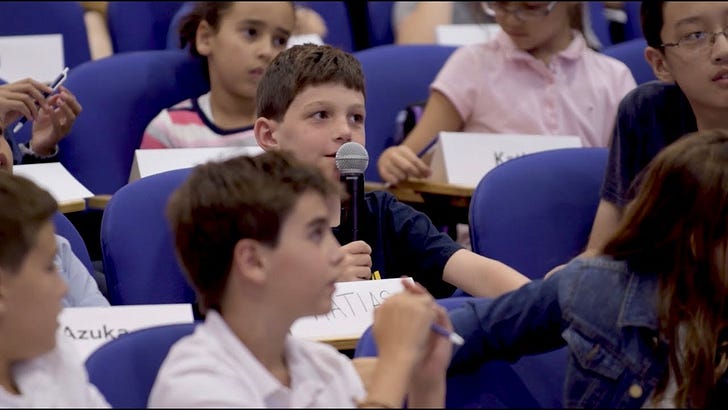Breakthrough in AI Literacy—Common Sense Media’s new AI ratings system
OpenAI’s ChatGPT was released one year ago on November 30th, 2022. It would not be exaggerating to say that it took the world by storm. Reuters writer Krystal Hu reported on Feb. 1, 2023, “ChatGPT, the popular chatbot from OpenAI, is estimated to have reached 100 million monthly active users in January, just two months after launch, making it the fastest-growing consumer application in history.”
Just as the NCSA Mosaic browser (followed by Netscape Navigator) introduced the general population to the WorldWideWeb in 1993, ChatGPT has helped make generative AI a household word. A common descriptor I am hearing a lot is inflection point.
For example, a Nov. 14th article in MIT Technology Review by Melissa Heikkilä quotes Fei-Fei Li:
“This moment in AI is an inflection moment,” Fei-Fei Li told me recently. Li is co-director of Stanford’s Human-Centered AI Institute and one of the most prominent computer science researchers of our time. She is best known for creating ImageNet, a popular image data set that was pivotal in allowing researchers to train modern AI systems.
Two things have happened, Li explains. Generative AI has caused the public to wake up to AI technology, she says, because it’s behind concrete tools, such as ChatGPT, that people can try out for themselves. And as a result, businesses have realized that AI technology such as text generation can make them money, and they have started rolling these technologies out in more products for the real world. “Because of that, it impacts our world in a more profound way,” Li says.
Businesses rolling these technologies out in more products include businesses in the education market. So I was thrilled to see how Common Sense Media has responded—they have launched a new ratings and review system. In their launch announcement November 15, Tracy Pizzo Frey, their Senior Advisor on AI, writes:
Artificial intelligence is predicted to be one of the largest disruptive changes we will experience in our lifetimes. While these powerful technologies are not new, AI is evolving at an unprecedented pace, and without sufficient guardrails to protect human rights or democracy.
At the same time, the public lacks understanding about the different types of AI, how they work, their benefits, and their pitfalls—particularly for kids and families. AI's "view" of the world can shape impressionable minds and their sense of what is "good" or "normal," and with little accountability. What happens to our children when they are exposed to the worldview of a biased algorithm repeatedly and over time? What view of the world will they assume is correct, and how will this inform their interactions with real people and society?
One of the best ways for parents and educators to help is to increase their own understanding of how AI tools work. At Common Sense, we've been using our independent, research-backed expertise to help families and educators make informed choices about the media and technology in kids' lives for 20 years. That means we have a responsibility to carefully rate and review AI and other emerging technologies that will become integral in the digital lives of kids and families. And today we've launched the first 10 reviews using our new AI ratings and reviews system.
The first 10 reviews include ChatGPT, Bard, DALL-E, Stable Diffusion, My AI, Khanmigo, and others. Common Sense bases these reviews on eight “Common Sense AI Principles” that help reviewers to assess how products align. Here are the principles:
Put People First
Promote Learning
Prioritize Fairness
Help People Connect
Be Trustworthy
Protect Our Privacy
Keep Kids & Teens Safe
Be Transparent & Accountable
You can find the detailed descriptions for each principle here. I encourage you to read them. They describe additional testing using a set of known benchmarks across five areas: performance, robustness, information security, truthfulness, and risk of representational and allocation harms.
They explain in great detail how they review and rate AI products here. Here’s the intro:
Technical excellence is not enough.
At Common Sense, we know that successful artificial intelligence is built with responsibility, ethics, and inclusion by design. This means that technical excellence alone is not enough for AI systems—AI is sociotechnical, which means that the technology cannot be separated from the humans and the human-created processes that inform, shape, and develop its use.
That's why our AI product reviews are contextual, taking into account the societal landscape in which the products will be used and actively seeking what information might be missing or invisible to an AI system. Our ratings and reviews act as "nutrition" labels for AI. They describe a product's opportunities, limitations, and risks in a clear and consistent way, putting the information you need at your fingertips.
The work on this initiative has been supported by Craig Newmark Philanthropies (Craigslist) “to ensure that AI has a positive influence on kids.” In addition to the ratings, they have developed excellent and much needed curricular resources for classrooms which you can find HERE.
So far I have reviewed Lesson 1, What is AI? and Lesson 3, AI Chatbots: Who’s Behind the Screen. Most lessons include videos, handouts, slides, and a teachers guide. The lessons say they are for Grades 6-12 but I think they could easily be adapted for middle school and even younger. I thought the AI Chatbots lesson was really well done (15 min) and think kids as young as 7 or 8, if they’re using chatbots at all, should be watching it with the adults in their lives.
Five stars+ to Common Sense Media and Common Sense Education for rolling this out.
I want to mention one more excellent resource for your co-viewing with kids and students—Artificial Intelligence for Kids with Hod Lipson, Professor, Columbia Engineering. This live presentation by Hod Lipson to an audience of kids ages 6 to 16 took place on September 11, 2017. The kids’ questions are seriously awesome and very current today. Don’t miss watching it. It’s 43 minutes long, perfect for an evening family event. In the classroom, you could break it up into two shorter viewings.
Share The Interconnect with an educator you love.
Take good care. Be well.



